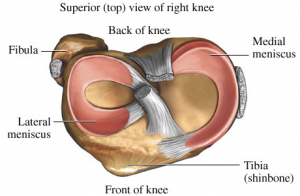By Cameron Walsh

Meniscus tears are a common knee injury occurring in both sporting and everyday scenarios. The location of the pain can be felt either on the inside or outside of the knee joint, depending on which Meniscus has been injured. Anatomically speaking, the Meniscus is a horseshoe shaped piece of fibrous-like cartilage which sits around the outer (lateral) or inner (medial) borders of the tibial plateau (see picture below). They are responsible for supplying structural integrity to the knee, specifically when bent or twisted. Injuries to the Meniscus are either traumatic or wear-and-tear based in nature. In the case of traumatic injuries, there are often injuries to other local structures such as the Anterior Cruciate Ligament (ACL), Posterior Cruciate Ligament (PCL) or Collateral ligaments. Due to the poor blood supply of the Meniscus, surgery is sometimes indicated when injured.
Causes of a Meniscus Tear
Biomechanically speaking, a Meniscus is often torn when the knee is twisted whilst in a flexed position. An example of this would be a change in direction whilst playing sport. Other common causes may include heavy loading in a deep squatting position, or seemingly innocent movements such as using stairs or walking/jogging. As a result of these positions the fibrocartilaginous tissue becomes overloaded and tears, leaving a moveable fragment. Degenerative tears are slightly different in that they are due to a breakdown in the collagen fibres which make up the Meniscus. These degenerative tears have a tendency to gradually occur over time and may then be made worse after a specific activity or incident.
Signs and Symptoms
Other than the immediate or gradual onset of pain, swelling may be noted but not always. You may notice a clicking sound, or a locking sensation whereby the knee will not fully straighten. The knee may also give way. When we consider the mechanism of injury (as noted earlier), simple movements such as turning in bed, getting out of a car or any movement creating a bending and twisting action in the knee will elicit pain.
Can MGS help you diagnose and treat a Meniscus Tear?
The simple answer is yes and no! Physiotherapists have a number of different diagnostic tests they can perform to determine whether a tear is present and more importantly how severe the tear is likely to be. The treatment of a tear will usually depend on the severity. Higher grade tears usually require surgery whereas lower grade tears can often be managed conservatively. If you are considering surgery it is highly recommended that you discuss this with your physio first before embarking down that route! The appropriate exercise Rehab program often obtains good results. Even if the meniscal tear ends up requiring surgery, the right type of guided exercise program beforehand (known as Prehab) can influence a more positive outcome from the surgery.
